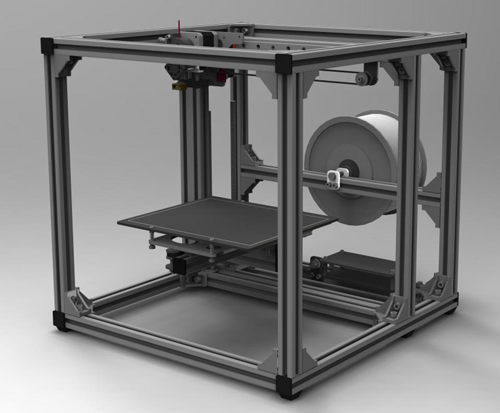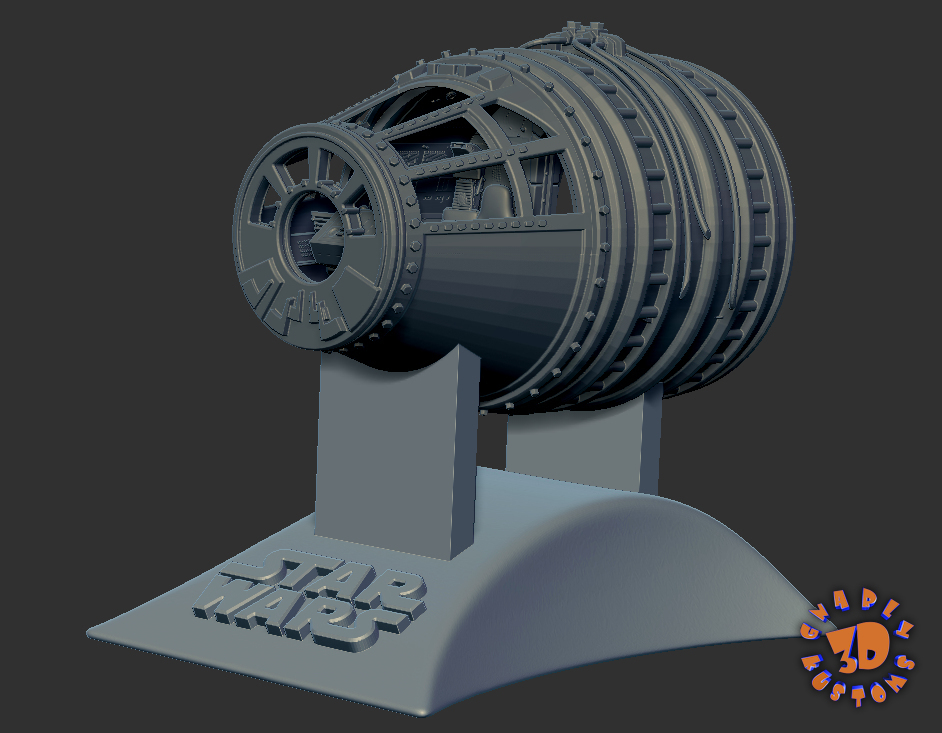Best jewelry 3d printer
5 Best 3D Printers For Jewelry 2022 (All Price Ranges!)
3D printing jewelry rarely means 3D printing actual wearable pieces made from filament or resin, but instead using a jewelry 3D printer to create high-resolution wax models of the eventual gold or platinum design, used to create a mold that is burned out and cast via investment casting or lost wax casting.
- We also have an article ranking some of the most beautiful 3D printed jewelry.
In fact, much jewelry is now created this way. There are entire factories of resin 3D printers set up to create castable wax resin models to be molded and then melted to create high-end jewelry.
However, owning your own jewelry 3D printer gives you more control over your production, and saves you money compared with paying someone to print your own molds. Castable resin molds can be produced for rings and other jewelry pieces for just the cost of the resin used, perhaps a dollar or two, whereas you could end up paying $25+ for someone to print it for you.
| Name | Build volume (mm) | Price | Where to buy |
|---|---|---|---|
| Elegoo Mars 2 Pro | 129 x 80 x 160 | $250 | Elegoo here |
| Peopoly Phenom | 276 x 155 x 400 | $1,999 | Matterhackers here |
| Formlabs Form 3 | 145 x 145 x 185 | $3,499 | Dynamism Store here |
| Solidscape S325 | 6" x 6" x 4" | Quote | Get a Quote here |
| EnvisionTEC D4K Jewelry | 148 x 83 x 110 | Quote | Get a Quote here |
- CAD File: Either design your own jewelry piece on CAD software, pay someone to design your desired piece, or pay for an existing jewelry STL file online and download it.
- Slice & Prepare: If not already an STL or other compatible file, export it as one. Then import it into your 3D slicer and slice it for printing.

- Print the model: Use a castable wax resin designed for jewelry model 3D printing.
- Molding: Pour your molding material over your wax jewelry model, and leave it to harden.
- Melt the wax: Heat your new mold so that the original wax model melts and evaporates, leaving a hollow empty space inside with the exact dimensions of your planned jewelry piece.
- Casting: Pour melted liquid metal e.g. gold, silver or platinum into the mold to cast it.
Resin 3D printers are considered the best 3D printers for jewelry. They are used with specialized castable wax resins, which rather than going from solid to liquid when heated, transition directly into a gas from their solid state.
Though prevalent, FDM 3D printers are very rarely used as 3D printers for jewelry. They are not capable of the same resolutions, crisp surface finishes or accuracies required for intricate and delicate jewelry pieces. Jewelry 3D prints need to be incredibly highly detailed and accurate — an inaccurate mold will create inaccurate and unimpressive jewelry.
Jewelry 3D prints need to be incredibly highly detailed and accurate — an inaccurate mold will create inaccurate and unimpressive jewelry.
Additionally, the better the jewelry 3D printer quality, the less finishing the resulting jewelry piece will need to perfect it.
What do jewelry 3D printers make?Usually they 3D print wax jewelry molds, for example of ring designs before any stones are set, or individual chain links.
However, they can also be used to create like-for-like “fitting pieces” for testing the fit of an as-yet unmade ring for a client’s finger. Though making the final ring would be expensive and take time, an exact replica can be made on a jewelry 3D printer in just minutes to test the sizing.
This saves the trouble of creating a piece just to find it doesn’t fit properly. Whereas for jewelry molds specialized castable resins are required, for these fitting pieces standard resins can be used.
3DSourced is reader-supported. When you buy through links on our site, we may earn an affiliate commission. Learn more
Learn more
The best 3D printers for jewelry
1 — Elegoo Mars 2 Pro
- Jewelry 3D printer price: $250 — Available at Elegoo store here / Available on Amazon here
- Build volume: 129 x 80 x 160 mm
Featuring a 6-inch monochrome LCD screen offering HD 2K resolution, the Elegoo Mars 2 Pro offers precise jewelry printing for the price. Rather than DLP or SLA, the Mars 2 Pro uses LCD printing to cure entire resin layers at once, quickening print speeds and able to print at 30-50mm/h.This is the detail we achieved when using the Elegoo Mars 2 pro – enough for fine jewelry pieces.
Other 3D printers for jewelry on this list offer better quality, but for the price the Mars 2 Pro is a great option. It is sturdily built with its CNC-machined aluminum structure for better stability, and the mono LCD is upgraded for improved lifespan to save you money over the long term. It’s one of the best 3D printers for jewelry under $500.
The Elegoo Mars has Z-axis resolutions of up to 0.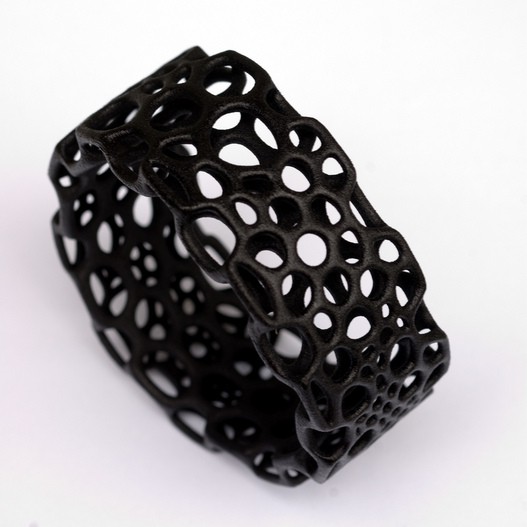 00125mm, XY-resolutions of 0.05mm, and weighs 6.2kg. It also supports 12 different languages, so if you’re not a native English speaker you can choose your own language.
00125mm, XY-resolutions of 0.05mm, and weighs 6.2kg. It also supports 12 different languages, so if you’re not a native English speaker you can choose your own language.
The video below even shows, from start to finish, how accurately you can make wax models for gold jewelry using a standard Elegoo Mars. Even this standard version produces good quality wax models, and the Elegoo Mars 2 Pro comes with several upgrades on the original.Printing on our Elegoo Mars 2 Pro – read our full review here.
2 — Peopoly Phenom
- Jewelry 3D printer price: $1,999 — Available on Matterhackers here
- Build volume: 276 x 155 x 400 mm
The Peopoly Phenom offers truly enormous printing volumes, almost unheard of for a jewelry 3D printer. For jewelers looking to produce many rings or other pieces simultaneously, this larger volume provides space for dozens of wax jewelry models. If you’re in demand for jewelry and want to make as many as possible then this larger build volume is crucial.
With its 4K high resolution projection quality using MSLA technologies, the Phenom produces crisp, accurate and consistent jewelry molds. MSLA takes elements from both LED and LCD technologies, the result being fast, accurate and repeatable jewelry 3D printing.
- The even larger version, the Peopoly Phenom L, is available here.
- For faster print speeds, the premium Peopoly Noir is available here.
The Phenom uses Chitubox resin 3D slicer, useful if you’ve previously used it previously on another printer. Overall, it’s one of the best 3D printers for jewelry, and a great choice for people looking to make large numbers of castable wax jewelry models.
3 — Formlabs Form 3
- 3D for jewelry price: $3,499 — Available on Dynamism here
- Build volume: 145 x 145 x 185 mm
Seen as the gold-standard in professional resin printing, the Form 3 is capable of fantastic precision, with its new custom Light Processing Unit (LPU) using lenses and mirrors to accurately print jewelry models.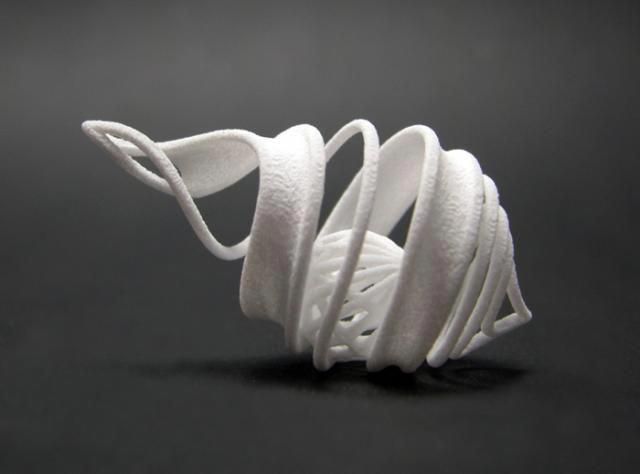
For the price, the Form 3 offers 25-micron resolutions and very consistent and repeatable printing. For those looking for a 3D printer for jewelry able to produce the same design flawlessly again and again, or for producing custom intricate designs, the Form 3 can handle both without issue.
Formlabs make their own castable wax resins designed for jewelry with “crisp settings, sharp prongs and smooth shanks.” Within the Formlabs workflow therefore is a complete jewelry production process for wax models, though the Form 3 also excels as a dental 3D printer and in other industries, too.The Form 4, and several jewelry wax models it 3D printed.
4 — Solidscape S325
- Price: Requires a quote
- Build volume: 6” x 6” x 4”
Soliscape make specially designed jewelry 3D printers, so any Solidscape printer you buy is optimized for jewelry printing. Whereas other printers like the Form 3 are designed to excel in a number of industries, the Solidscape S325 is designed with jewelry wholly in mind.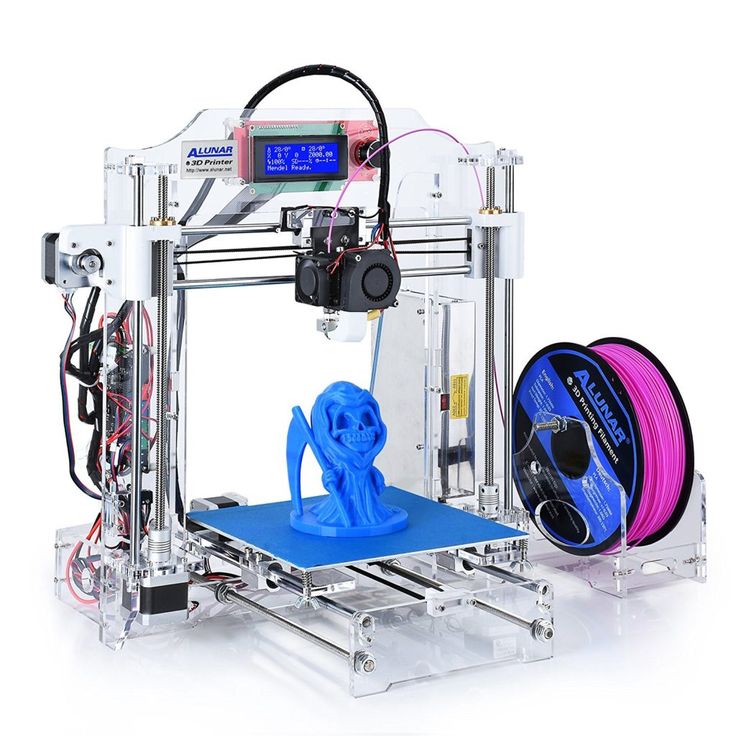
The S325 is the cheapest of Solidscape’s jewelry 3D printer range. It offers great accuracy, material jetting wax models for the precise and effective investment casting of precious metals. Solidscape stress that all their models are castable in gold and platinum, and do not expand or shrink during the investment casting process.
The S325 is capable of 0.001-inch layer thicknesses, with accuracies of 0.005 inches. Overall, as a specialized 3D printer for jewelry, Solidscape have a rich history in jewelry 3D printing and can be trusted to deliver high-quality and precise ring wax models, time and time again.
Get a quote*
*One of our trusted partners will be in touch following a quote request.Compressed by jpeg-recompress
5 — EnvisionTEC D4K Pro Jewelry 3D printer
- Jewelry 3D printer price: Requires a quote
- Build volume: 148 x 83 x 110 mm
Described by EnvisionTEC are the highest resolution professional-grade desktop 3D printer, as well as claiming to have the fastest speed, the D4K is well suited to jewelry 3D printing. Speed and accuracy are key to jewelry production, with the printer’s 4K UV DLP projector able to create crisp wax models at speed to be cast into stunning jewelry pieces.
Speed and accuracy are key to jewelry production, with the printer’s 4K UV DLP projector able to create crisp wax models at speed to be cast into stunning jewelry pieces.
EnvisionTEC are the originators of DLP 3D printing, having pioneered the process more than a decade ago. Now, their advanced D4K Pro can produce accuracies of up to 25 microns in the XY resolution, and 1 micron on the Z axis.
The jewelry 3D printer works well with EnvisionTEC’s WIC100 Series wax material, used to then burn out and investment cast precious jewelry. Though it’s an industrial 3D printer costing over $10,000, larger jewelers will find the D4K one of the best 3D jewelry mold printers.
Get a quote*
*One of our trusted partners will be in touch following a quote request.
Advantages of owning a jewelry 3D printer
- Saves money long term: rather than paying a 3D printing service $20+ to print your mold for you, you can print your own wax jewelry molds for just a dollar each.

- Control your own jewelry production: with the ability to print jewelry in-house, you control your own workflow and apart from resin shortages, cannot be slowed down by supplier failures. Your order will always be top priority.
- Fast: going from CAD model to a piece ready to be investment cast is quick, especially when you can print and cast everything in one place.
- Very accurate: precise, smooth and intricate jewelry is not an issue for jewelry 3D printers, some able to print with below 10-micron accuracy to capture your ring’s most delicate and beautiful features.
- Repeatable and scalable: 3D printers for jewelry can create potentially dozens of identical or customized ring molds at once, perfect for scalable jewelry production.
6 Best 3D Printers For Jewelry (2022 Update)
- Last Updated On January 3, 2022
Whether you’re starting a new hobby or a new business, 3D printing jewelry is an exciting project to take on.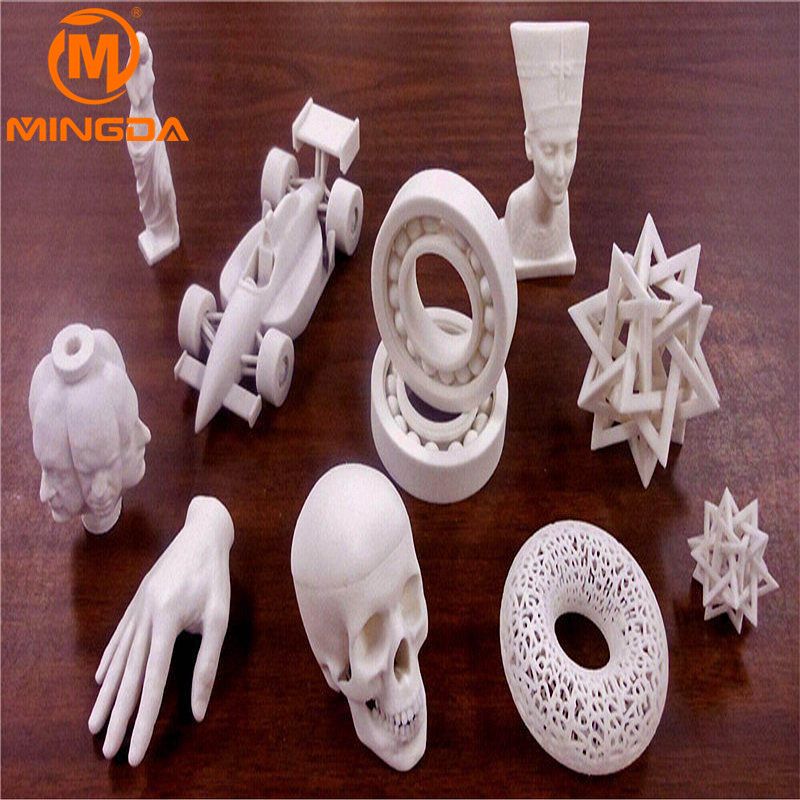
A few clicks and some resin, and you magically get a completely customized piece of fine jewelry – it’s like alchemy is finally real!
At this point you want to make your dream a reality. We’re going to take a dive into the different printers you have as options, and then we’ll get into some things you need to know about jewelry making so you’re well-equipped to print your first piece.
Anycubic Photon
3D Printing Technology: MSLA
Get Discount
Check Latest Price
Phrozen Sonic Mini 4k
3D Printing Technology: LCD
Check Official Store
Check Latest Price
Peopoly Moai
3D Printing Technology: SLA
Check Latest Price
Table of Contents
- Top 3D Printer For Jewelry At A Glance
- 1. Phrozen Sonic Mini 4K – Our Choice
- 2. Formlabs Form 2 – Best High-End
- 3.
 Peopoly Moai – Best Value Resin
Peopoly Moai – Best Value Resin - 4. Anycubic Photon – Best Budget SLA
- 5. Ender 3 Pro – Best Budget FDM
- 6. Solidscape S370 – Professional 3D Jewelry Printer
- How Does 3D Printing Jewelry Work?
- Process Of Jewelry 3D Printing
- Alternative 3D Printing Processes
- Pros And Cons Of Each 3D Printing Method For Making Jewelry
- Why 3D Print Jewelry?
- Conclusion
Top 3D Printer For Jewelry At A Glance
We’ve researched over 10 different 3D printers for jewelry making for our own business and below are our top 6.
- Phrozen Sonic Mini 4K (Best Overall – Editor’s Choice)
- Formlabs Form 2 (Best High-end)
- Peopoly Moai (Best Value – Premium Choice)
- Anycubic Photon (Best Budget Pick)
- Ender 3 Pro (Best Budget FDM)
- Solidscape S370 (Professional 3D Jewelry Printer)
1.
 Phrozen Sonic Mini 4K – Our Choice
Phrozen Sonic Mini 4K – Our Choice If you want exceptional print quality without breaking the bank then the new and improved Phrozen Sonic Mini 4K is for you.
Compared to other affordable resin 3D printers like the Anycubic Photon S and Elegoo Mars 2 Pro, we found the printing quality superior in the former. The XY layer resolution of the Mini 4K is 35 microns vs the 50 microns of those two printers.
As you know, in the world of television and mobile phones, 4K screens produce high-quality images. Similarly, thanks to the 4K LCD screen with the Mini 4K, you’ll get a better print resolution.
In all fairness, the differences between prints from the three printers weren’t pronounced. But in detail-packed jewelry, you’ll notice the power of the 4K LCD.
The Sonic Mini 4K also prints faster – one layer in 2 seconds fast (although the newer models of the Photon and Mars are keeping up).
If you want a beginner-friendly resin 3D printer for jewelry, then the Mini 4K is for you. It’s that easy to use. Just plug-in, level, and start printing. The default settings in Chitubox work without any adjustments although you’ll have to tweak it for certain designs.
It’s that easy to use. Just plug-in, level, and start printing. The default settings in Chitubox work without any adjustments although you’ll have to tweak it for certain designs.
In terms of printer noise, the Sonic Mini 4K is a bit noisier than the original the Sonic Mini. The noise mainly comes from Mini’s Z-axis stepper motor during the changing of layers.
All in all, for 3D printing jewelry and miniatures you can’t go wrong with the Sonic Mini 4K. It excels where print details is a must.
- Exceptional print quality for super fine details
- Easy to level the bed
- Built tough
- Touch screen is very responsive
- Beginner-friendly
- Possible flex in the build plate arm for large print areas
- Screen can get easily damaged
Check Official Store
Check Latest Price
2.
 Formlabs Form 2 – Best High-End
Formlabs Form 2 – Best High-End You get what you pay for with the Formlabs Form 2. This is an SLA 3D printer that checks every box on your list. The accuracy and ease-of-use of this printer are going to pay for itself in no time at all, which is a good justification for the price tag (if you can swallow it).
The build volume is 115 x 65 x 155 mm, which won’t be a problem for you jewelry 3D printing. The great thing about this unit is it’s a true desktop 3D printer. It doesn’t take up any space at all so you can pile a bunch of these bad boys on your desk to start your jewelry empire! Well, either that or it’s easy to hide so your spouse doesn’t know about your new hobby.
Speaking of hiding, the Form 2 prints quietly so you can keep it in your bedroom or in your office and it won’t disturb you.
The folks at Formlabs don’t live under a rock, either. They realized how many people were using their machine for printing jewelry so they released a special SLA resin that’s wax-castable. They’ve got a great inventory of other resins to help out with a ton of different projects you’re going to work on.
They’ve got a great inventory of other resins to help out with a ton of different projects you’re going to work on.
Their company is well-established, so their auxiliary programs are really sleek and easy to use. Not to mention, their printer looks really futuristic – almost like a piece of art.
A great thing about this printer is you don’t have to mess with the liquid resin in the trough at all. You just put in a canister, and the machine does all the work for you. It even has an automatic wiping system that will clean up the print as you go along. It’s fast and it will do a great job printing intricate details in your jewelry.
If you want the top of the line 3D printer for jewelry then the Form 2 is for you.
- Very easy to set up and use
- Software is great
- Great curb appeal
- Super high accuracy
- Easy resin loading
- Very quiet operation
- Expensive
- Post-processing required on all prints
- Resin fill-ups are expensive (sound familiar?)
Check Latest Price
3.
 Peopoly Moai – Best Value Resin
Peopoly Moai – Best Value Resin The logical next printer to look at on this list is the Peopoly Moai. Everything you love about SLA 3D printers, at a more reasonable price.
This checks the same boxes as the Form 2; it’s super accurate, quiet to operate, easy to use, and you can easily print using a resin bath. The difference is that this machine is a lot less expensive, and the resin is also less expensive. The other thing that’s great about the Moai is it allows 3rd party resin!
This machine isn’t as polished or sophisticated as the Formlabs’ 3D printer, but it is no stick in the mud, either. It will deliver great accuracy and precision for a fair price. Peopoly’s Moai resin 3D printer is an excellent choice for beginners who have the cash. It’s also the perfect choice for people who like to experiment and tinker.
Since it’s open-source and allows 3rd party resins, you have a lot of room to test the boundaries of this printer.
We recommend the Moai as the best jewelry 3D printer for beginners and it’s equally friendly to limit-testers and experimenters.
- Accepts 3rd party resins
- Robust assembly
- Great supporting documents
- Good value
- Beginner-friendly
- Assembly required
- Prints are sometimes messy
Check Latest Price
4.
 Anycubic Photon – Best Budget SLA
Anycubic Photon – Best Budget SLA All this talk about the intricacies and costs associated with resin 3D printing, did you know there’s a true budget SLA 3D printer? For a couple of hundred bucks, you can have a fully-operational SLA printer to start your jewelry 3D printing adventure.
But don’t be fooled, there’s a difference between “inexpensive” and “cheap”, and the Anycubic Photon is far from cheap. The price might be low, but the quality you get is very good.
Significantly better than any FDM printer can achieve.
25-micron resolution, to be exact. It’s a small unit, which is a pro and a con. It takes up less desk space, but you can do less with it. Of course, with printing jewelry, you shouldn’t care a ton about the build volume, but it’s something to keep in mind.
The Photon S has a dual-linear rails which means fewer vibrations. This translates to more reliable prints and higher precision (it reduces the dreaded “Z-wobble” that can cause prints to have strange lines although it wasn’t a huge concern with the original Photon and I’ve never experienced it).
There are also fewer fumes, so it’s safer to work around. It cost <$100 more than the Photon, however, it might be worth it if you want a better touchscreen and an improved, more stable Z-axis.
The other thing to keep in mind is this doesn’t have the built-in safety features that the other SLA printers on this list have. Yes, printing with resin is dangerous. Do your own research and make sure you get the required protective equipment (nitrile gloves, an air purifier, 99% isopropyl alcohol, etc.). The setup and cleaning process is manual for this printer, so be ready to get your hands dirty and have your patience tested.
Just keep in mind how low the cost of this unit is. Sure, there are more precautions to take and more time required for each step of the process. But remember that you’re saving thousands of dollars here. It also might prove to be a good exercise to learn SLA printing without all the bells and whistles. It will give you a deeper appreciation for when you upgrade to a more expensive unit.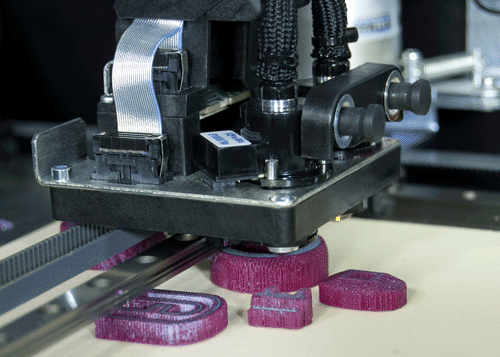
- Very inexpensive
- Great accuracy
- Small overall dimensions
- A true desktop unit
- Very manual process
- No luxurious automation
- Small build volume
Click For Best Price
Check Latest Price
5. Ender 3 Pro – Best Budget FDM
For a couple of hundred bucks, you can start learning how to make custom jewelry. The Ender 3 Pro is not the most polished or glamorous printer, but it’s a workhorse.
The Ender 3 Pro is not the most polished or glamorous printer, but it’s a workhorse.
A lot of people consider it the best FDM 3D printer for jewelry in its price category, myself included. What you get are reasonably accurate and quality prints (for a non-resin 3D printer). You can start learning the process and experimenting without breaking the bank.
The 3D printer is also really sturdy and durable.
If you’re not comfortable investing thousands into a 3D printer, the Ender 3 Pro gives you the options to start small and see how passionate you are about the space.
Unlike the rest of the 3D printers in this list, since this is an FDM 3D printer you’re not pigeon-holed to just using resins. Sure, it’s not the best 3D printing tech for making jewelry, but it can do a ton of other stuff. You can enjoy the full range of freedom that comes with having an FDM printer.
That said, FDM 3D printers print quality are noticeably less smooth and accurate than their resin 3D printer counterparts.
Admittedly, sometimes I break things just so I can 3D print replacements – and that’s something you can’t do with an SLA 3D printer.
- Very budget-friendly
- Robust machine
- Decent accuracy
- High-quality print potential
- Some reliability issues
- Assembly required
- Print bed is sometimes warped
Click For Best Price
Check Latest Price
6.
 Solidscape S370 – Professional 3D Jewelry Printer
Solidscape S370 – Professional 3D Jewelry Printer The last 3D printer on the list is from Solidscape. Before reading further, I need to point out that it’s a professional-grade, top-of-the-line jewelry 3D printer, and so it’s priced accordingly. In fact, the price tag sits north of $55,000. It’s an investment for a professional, and not for a hobbyist. With that out of the way, let’s look at how this can transform your custom 3d printer jewelry business. So it’s an SLA printer on steroids. It avoids everything you hate about the other SLA 3d printers and adds a ton of extra benefits.
The post-processing using dissolvable supports which means it’s mess-free for you. The set up takes no time at all, and continued use is just as easy. The benefits don’t stop there. The machine will automatically wax-cast your piece of jewelry. If you recall, with the other SLA 3d printers there are a few steps between printing, and having a cast. On top of these points, it’s also insanely accurate.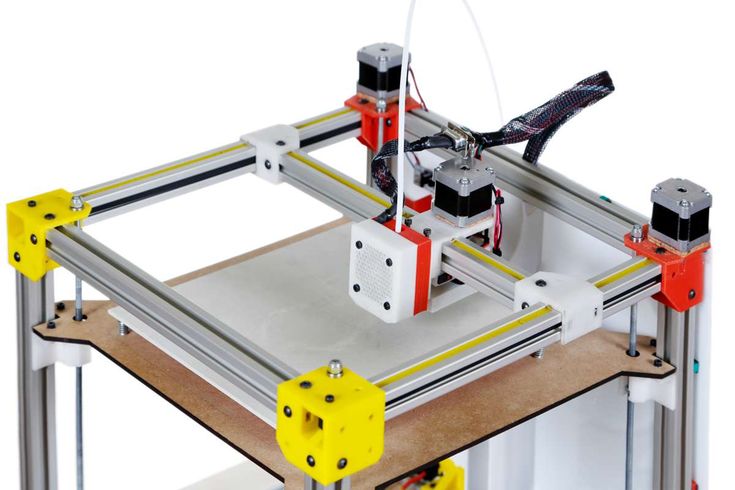 In fact, the layer thickness goes down as low as 6 microns. 12 times smaller than the thickness of a piece of hair.
In fact, the layer thickness goes down as low as 6 microns. 12 times smaller than the thickness of a piece of hair.
Solidscape’s printer will create pieces time and time again with no issues; it’s a highly repeatable and reliable machine. Everything about the S370 is automatic. They pride themselves on a one-touch operation. You touch the screen once and the print starts. Another few touches will do the post-processing and wax-casting for you. In other words, it’s one of the easiest and most convenient ways to 3d print jewelry.
So let’s circle back to the comment in the beginning. This is a machine for professionals or aspiring professionals. There is no doubt that this printer will elevate your business to the next level, but you need to make sure you have a business first. For that reason, I would strongly suggest you start with another printer first and learn the ropes. Exploit a less expensive printer as a way to prove your concept and learn the hard lessons. When you’re ready, this machine is here for you.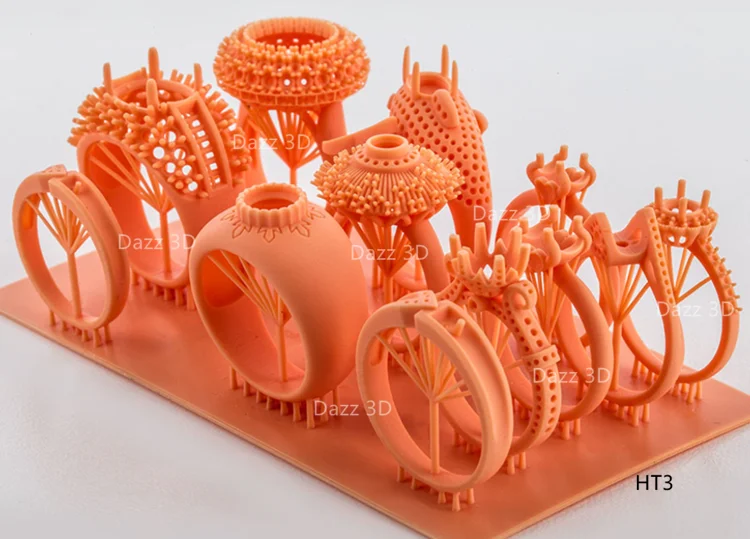 It was made specifically for 3d printing jewelry, and no other machine does it better. Essentially, it is the best 3d printer for jewelry.
It was made specifically for 3d printing jewelry, and no other machine does it better. Essentially, it is the best 3d printer for jewelry.
- Very user-friendly
- Unbelievable accuracy
- Creates ultra-intricate pieces
- Automatically wax-casts
- Mess free post-processing
- Repeatable and reliable
- The best option for professionals
- Easy setup & easy operation
- Convenient
- The cost is a heavy investment
Check Latest Price
How Does 3D Printing Jewelry Work?
Just to clear things up, you’re not going to be printing custom gold jewelry right from the nozzle of your 3d printer. You’re going to be printing a high-detail mold that you’ll use to make your custom jewelry. If you’ve made jewelry the traditional way before, you know the low-tech method of making these molds. Either they are hand-crafted, or you can use a CNC mill to cut one. You make a version of what you want the ring to be, you make a mold around it, pour in your molten silver or gold, then you get your ring!
You’re going to be printing a high-detail mold that you’ll use to make your custom jewelry. If you’ve made jewelry the traditional way before, you know the low-tech method of making these molds. Either they are hand-crafted, or you can use a CNC mill to cut one. You make a version of what you want the ring to be, you make a mold around it, pour in your molten silver or gold, then you get your ring!
This uses the exact same process, but it launches it into the 21st century. Instead of a mill or hand-carving, we’re going to be using a 3d printer. If you’re familiar with hobby 3d printers, you’re on the right track. Those desktop units are one example of 3d printing technology we can use, but there are some others that might work better for you.
Process Of Jewelry 3D Printing
In case you don’t know the process for 3D printing jewelry, let’s take a quick look at it.
- The first step is to either design or find a design for the jewelry. This will be done on a CAD program, or you can find a ton of different models online.

- Next, you 3D print your piece of jewelry using resin or a special wax. No, we’re not 3D printing gold.
- After that, you take your wax or resin piece of jewelry and get it ready for casting.
- From there, you’ll make a mold. The result is a mold that has the cutout of your piece of jewelry.
- Now, pour your molten precious metal into that mold. After some time, the magic is done! You have a shiny ring!
That’s the easy part – the hard part is figuring out which 3d printer is perfect for you. Like a “choose your own adventure” book, you have some options to start you down your path.
Alternative 3D Printing ProcessesYes, there are options when it comes to 3d printing technology. Those traditional 3d printers you may have seen on the internet or in your friend’s garage are what we call FDM or FFF printers. Fused Deposition Modeling, or Fused Filament Fabrication. We’re using fusion, or sticking a hot thing to itself, to make the part. The plastic is hot, the layers build up and stick to each other, and then they cool and you have your final model.
The plastic is hot, the layers build up and stick to each other, and then they cool and you have your final model.
The other method that we’re going to look at is called SLA. It’s a little funkier and tougher to understand. SLA stands for Stereolithography Apparatus. Big words. Basically, it uses science and lasers to form a 3d printed part from a trough of liquid resin. The great thing about SLA is it can make really strong pieces and can print with more robust material options. SLA is a more favorable tech for jewelry, but FDM is a more universal tech.
Pros And Cons Of Each 3D Printing Method For Making JewelryOkay, now that the nerdy science talk is over let’s take a look at why you should care about either of these 3d printing methods.
FFF / FDMThe big benefit of using an FDM printer for making jewelry is that the cost is really low. The upfront cost of the printer is lower, and the operating cost is much lower. Of course, there’s a downside to this. The quality you get with an FDM printer isn’t close to the quality you get with an SLA printer – it’s a lot worse.
The quality you get with an FDM printer isn’t close to the quality you get with an SLA printer – it’s a lot worse.
If your jewelry doesn’t require a lot of fine detail, then an FDM printer will be perfect for you. If you plan on printing a ton of non-jewelry projects, an FDM is the only option for you. SLA 3d printers are a lot more specific and niche-y. If you’re a jeweler, cosplayer, DIYer, and craftsperson, then an FDM printer is the best pick for you.
SLASLA printers were made to print resin, which is what you’ll use to make your jewelry. In that sense, SLA printers are made for exactly what you’re looking to do with them. Keep in mind that the upfront cost and the cost to run the machine are higher than FDM printers. Additionally, the resin is toxic, and with some SLA printers, you need to be careful when operating them.
With those two points out of the way, an SLA printer is exactly what most people need when they want to make their own jewelry. Why? Accuracy. The accuracy that an SLA printer can achieve is unbelievable. SLA is the only option if you’re looking for 3d printed jewelry with very fine detail. The other key feature is the strength of the materials used in an SLA printer. Resin is so much stronger than the default filament of an FDM printer.
Why? Accuracy. The accuracy that an SLA printer can achieve is unbelievable. SLA is the only option if you’re looking for 3d printed jewelry with very fine detail. The other key feature is the strength of the materials used in an SLA printer. Resin is so much stronger than the default filament of an FDM printer.
Why 3D Print Jewelry?If you want to make miniatures then check out our article for the best 3d printer for miniatures and figurines. If you want to see our picks for the best resin 3d printers for all price ranges then check out our guide here.
So we highlighted how to 3d print jewelry, and what goes into it. But are you totally convinced that you should even try it? Why 3d print jewelry? Why 3d print anything? The answer is exactly the same.
You have complete freedom over the designYou can make highly customized pieces and serve a niche market. If you can operate 3d CAD, you can completely design your own pieces to print.
You can 3d print such intricate pieces with odd geometries. This is great for modern pieces of jewelry.
For some pieces, there is no alternativeTraditional methods cannot scratch the surface of what you can make with a 3d printer. Some of your physics-defying pieces simply cannot be made on a CNC mill, so there’s no other option.
Prototyping is so much fasterI’m from a manufacturing background so trust me when I say that nothing compares to the lifecycle speed of a project when you’re using a 3d printer. The time between initial concept, designing, and getting your first working prototype could be 8 hours with a 3d printer. Traditional manufacturing methods might take a week for the same amount of progress.
The cost is so lowCrazy low. You don’t need a staff of trained machinists, design engineers, and project managers. You are the entire team. You don’t need a $250,000 CNC milling machine, a couple hundred dollars for a printer will suffice. You don’t need a $100 piece of raw material to prototype with, $5 is plenty. Finally, you don’t need to pay someone hourly to make it, you hit “go” and leave the room.
You are the entire team. You don’t need a $250,000 CNC milling machine, a couple hundred dollars for a printer will suffice. You don’t need a $100 piece of raw material to prototype with, $5 is plenty. Finally, you don’t need to pay someone hourly to make it, you hit “go” and leave the room.
So why 3d print jewelry? It’s faster, cheaper, more customizable, and you can make any shape you want.
Conclusion
I hope you get as excited as I do when I hear about all the different ways to 3D print jewelry and start growing your business, or just make fun pieces as gifts to family and friends. The process isn’t so hard to learn when you get your hands on a printer. Whether you go with an FDM printer, an SLA printer, a budget option, or a professional high-quality printer, you’re going to love the new world you unlock with your 3d printer. It’s faster and cheaper than traditional methods, and there’s huge profit potential.
Choose the Formlabs Form 2 if you want a serious SLA machine. The Anycubic Photon (or Photon S) and Phrozen Sonic Mini 4K are great options if you’re new to the resin 3D printer world and want to learn more about it. The Peopoly Moai is a great option for the in-betweeners who want good value without sacrificing quality. On the FDM side, you have the Ender 3 Pro which is the best budget option in this space.
The Anycubic Photon (or Photon S) and Phrozen Sonic Mini 4K are great options if you’re new to the resin 3D printer world and want to learn more about it. The Peopoly Moai is a great option for the in-betweeners who want good value without sacrificing quality. On the FDM side, you have the Ender 3 Pro which is the best budget option in this space.
If you’re picking an FDM printer, don’t be afraid to see what other markets you can print for. They aren’t strictly for 3D printing jewelry, so there’s a lot of opportunity for you. If you’re ready to invest in your business and grow it, consider the top-of-the-line Solidscape S370 printer. Enjoy your time with your new 3D printer! There’s a lot of learning and growing to be had!
Pat Nathaniel
Pat is the editor-in-chief at Printing Atoms. He has a BS in Mechanical Engineering from the University of Florida and wants to spread the word on 3D printing. When he's not writing, he likes to tinker with his Ender 3 Pro, test filament brands, and scuba dive.
Choice of technology and 3D printer for jewelry making, pros and cons
Currently, there are many new technologies that are designed to simplify production in various industries. Progress does not stand still and, despite some opponents, 3D printing has its own niche in the production of jewelry.
3D printing can speed up and reduce the cost of jewelry production due to the low cost of consumables. With 3D printers, jewelers have the ability to quickly change the design of a product and make prototypes at least several times a day. For many jewelry industries, 3D printing is becoming a good alternative or addition to milling machines and other equipment.
Until now, some believe that handmade is a sign of craftsmanship, especially when it comes to creative work, and models made using 3D modeling and printing are amateurish. But many people forget that behind the computer is the same person who not only mechanically presses the buttons, but also puts his soul into his creation.

Benefits of 3D printing
In order to understand how justified the use of a 3D printer is, you need to know how jewelry is made. This is very painstaking work. No wonder the expression "jewelry work" appeared, denoting a very delicate and complex work.
Any decoration begins with a sketch. Usually several sketches are made in order to accurately determine the design and location of the inserts. Not only stones are used as decor, it can be elements made of wood, bone, precious metals, it all depends on the designer's imagination.
At the next stage, the product is drawn in a 3D editor. This allows not only to visualize the future product, but also to correct some errors and inaccuracies made at the design stage.
Ring model
Some craftsmen still carve "stencils" by hand. Such work requires certain skills and perseverance. Usually this is how products are made that will be cast in a single copy.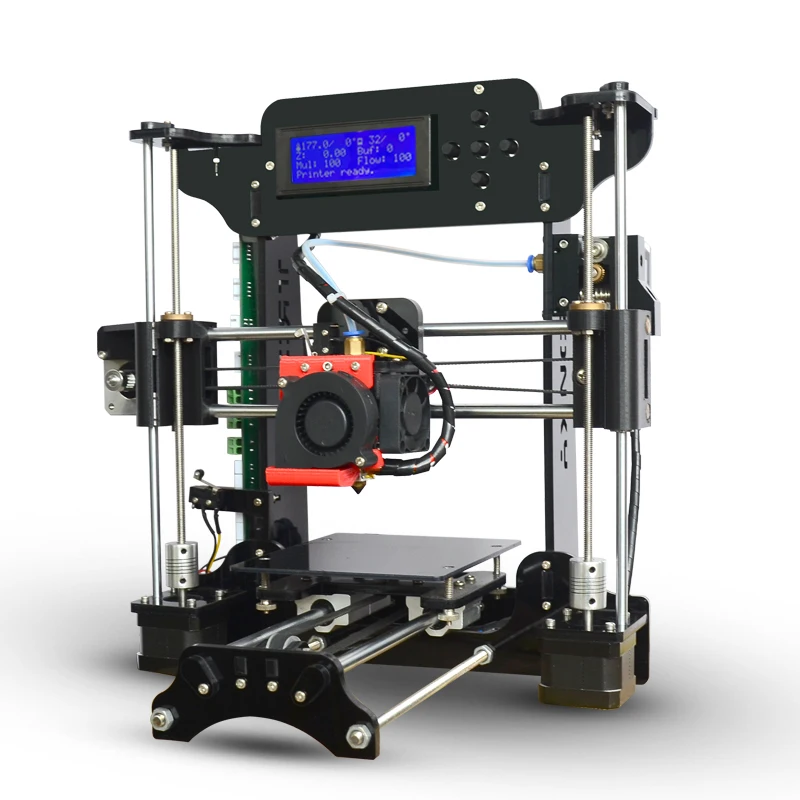
A finished 3D model can have several ways to be implemented in a physical version - this is milling or 3D printing.
Stencil milling
Currently, 3D printing is not much inferior in accuracy to a milling machine and often has a significant advantage in speed, despite the fact that after printing it is still necessary to separate the supports and clean up the points of contact with the model. Once a physical model has been obtained, it can be cast immediately if the material used is wax or a burnable polymer.
If it is necessary to cast a large batch of products, then a mold is made from the master model made with the help of special rubber for subsequent wax casting. There are many types of rubber that vary in hardness and curing temperature. Rubber is selected depending on the material from which the master model is made.
For pouring molds, a special machine is usually used - an injector. In some models, you can not only heat the wax, but also vacuum it or leave it under pressure. This helps to reduce the number and size of air bubbles for better pouring of the rubber mold.
This helps to reduce the number and size of air bubbles for better pouring of the rubber mold.
In home workshops, silicone is used instead of special rubber. After all, a special machine is needed to vulcanize rubber. But rubber molds are too soft and short-lived for making a large batch of stencils.
After making the required number of stencils, they are collected in "Christmas trees". "Elks" are waxes soldered to a wax rod. To save space, the distance between them is very small and they resemble fluffy Christmas trees, hence the name. The finished Christmas tree is weighed to calculate the required amount of metal. In some places, stones are immediately inserted into the stencils, unless another mounting option is provided.
Stencil Christmas trees
Ready "Christmas trees" are placed in a special cylindrical "cassette" without a bottom, which is called a flask, and filled with a gypsum-based molding mass.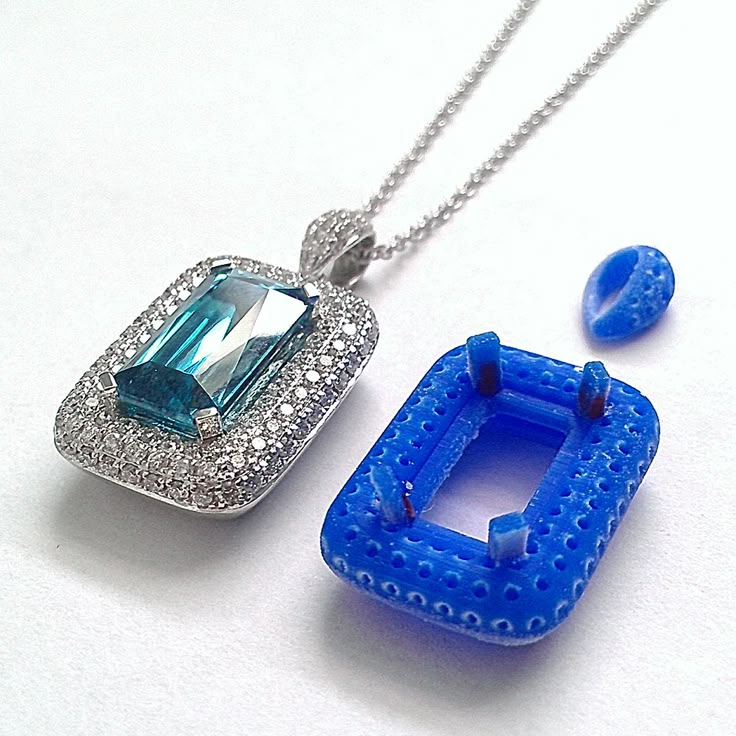 The flask with uncured gypsum must be evacuated to get rid of unnecessary air bubbles that can lead to defects on the surface of the finished casting.
The flask with uncured gypsum must be evacuated to get rid of unnecessary air bubbles that can lead to defects on the surface of the finished casting.
After hardening, the gypsum flask is sent to a muffle furnace to melt the wax.
The calcination mode is selected depending on the material of the wax. For wax or burnout polymer, different modes are needed in order for the material to be completely removed from the gypsum!!!!!!
When all the wax is melted, cavities are formed inside the gypsum, repeating the contours of the wax. Metal is poured into these voids. After casting, the flask is cooled and the gypsum mold mass is washed out under the pressure of water. The result is a metal Christmas tree.
Herringbone after casting
Finished castings are cut from the Christmas tree and washed, polished, if necessary, blackened by the master until the desired appearance is achieved.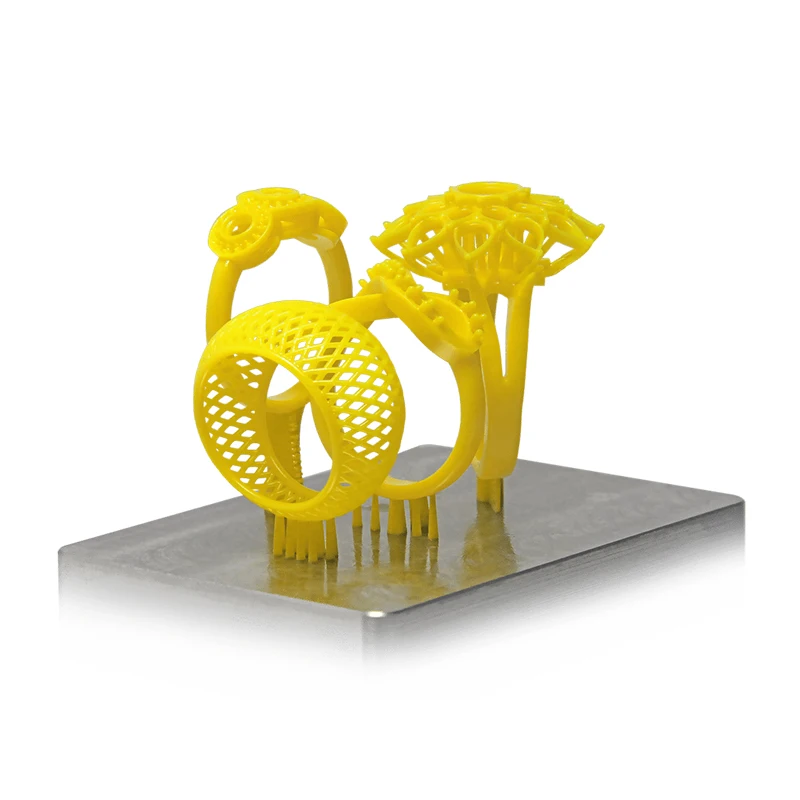
3D printers for jewelers
There are several 3D printing technologies that may be suitable for the needs of jewelers. Each has its pros and cons. Some 3D printers are ideal for a large workshop, and some are ideal for a small workshop.
SLA
SLA or stereolithography is based on the principle of layer-by-layer solidification of a photopolymer resin under the action of a UV beam. The UV beam is focused by means of mirrors on the surface of the resin and illuminates the model in layers.
How the SLA Printer Works
SLA 3D printers were the first to be noticed by jewelers. SLA devices are compact, while they have high printing accuracy.
Pros and cons
pros
Minuses
Print examples
From prototype to finished product
Cast and printed ring
Rating of printers.

Leadership among the production of SLA 3D printers is held by Formlabs.
Formlabs Form 3
Formlabs Form 3
Specifications:
XY resolution: 25 µm
Laser spot size: 85 µm
Laser power: One 250mW laser
Working area size: 14.5×14.5×18.5cm
Layer thickness: 25 – 300 µm
A professional 3D printer that is popular with professional jewelers and dentists.
Formlabs Form 3L
Formlabs Form 3L
Specifications:
XY resolution: 25 µm
Laser spot size: 85 µm
Laser power: One 250mW laser
Working area size: 33.5×20×30cm
Layer thickness: 25 – 300 µm
Form 3L differs from younger models in its large print area, which allows you to produce truly large products without losing quality and accuracy.
DLP/LCD
DLP is very similar to SLA, only as a source of UV radiation, to illuminate the photopolymer resin, not a directed beam of light is used, but a DLP projector. DLP printers illuminate the entire work area at once, so they greatly outperform SLA in print speed.
DLP printers illuminate the entire work area at once, so they greatly outperform SLA in print speed.
How a DLP Printer Works
Today it is one of the most affordable photopolymer 3D printing technologies. In terms of cost, LCD printers have caught up with the price level of amateur FDM. DLP printers are much more expensive due to the use of an expensive projector as a UV source.
The projector is of course more expensive, but more durable, on the other hand, the LCD display is not so expensive and can be easily seen, unlike the projector. What to choose each user decides for himself.
Pros and cons.
pros
Minuses
Print examples
Comparison between 3D printed master model and molded part
Burnout resin model and finished product
Demonstration of products cast with burnout resin
Rating of printers.
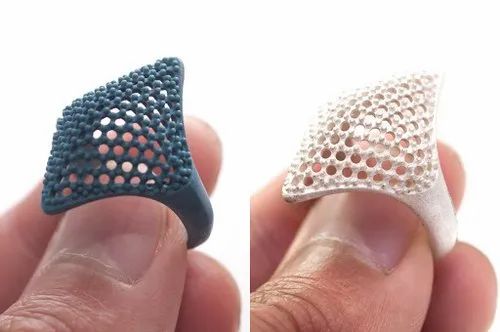
The print accuracy of LCD printers depends on the pixel size, so you should pay attention to this parameter when choosing a printer.
Anycubic Photon Mono
Anycubic Photon Mono
Specifications:
LCD display resolution: 2560x1620 (2K)
XY Positioning Accuracy: 0.051mm
UV wavelength: 405 nm
Working area size: 130x80x165 mm
Layer thickness: 0.01-0.15mm
The Anycubic Photon Mono is an inexpensive LCD machine ideal for hobby printing. The monochrome display allows you to reduce the exposure time and speed up printing.
Phrozen Sonic 4K
Phrozen Sonic 4K
Specifications:
LCD resolution: 6.1" 4K Mono LCD
XY positioning accuracy: 35 microns
UV wavelength: 405 nm
Working area size: 134x75x200 mm
Layer thickness: 0.01-0.30mm
Phrozen Sonic 4K is specifically designed for use in the dental and jewelry industry. Despite its compact size, the printer is not inferior to professional machines in accuracy, and the exposure time of one layer is only a few seconds.
Despite its compact size, the printer is not inferior to professional machines in accuracy, and the exposure time of one layer is only a few seconds.
Phrozen Sonic Mighty 4K
Phrozen Sonic Mighty 4K
Specifications:
LCD resolution: 9.3" 4K Mono LCD
XY positioning accuracy: 52 microns
UV wavelength: 405 nm
Working area size: 200x125x220 mm
Layer thickness: 0.01-0.3mm
Phrozen Sonic Mighty 4K is a professional device with a large print area. This allows you to quickly produce small batches of models.
Phrozen Sonic XL 4K
Phrozen Sonic XL 4K
Specifications:
LCD resolution: 8.9" 4K Mono-LCD
XY positioning accuracy: 50 microns
UV wavelength: 405 nm
Working area size: 190x120x200 mm
Layer thickness: 0.01-0.3mm
The Phrozen Sonic XL 4K is a professional machine with a large print area and a high resolution monochrome LCD display.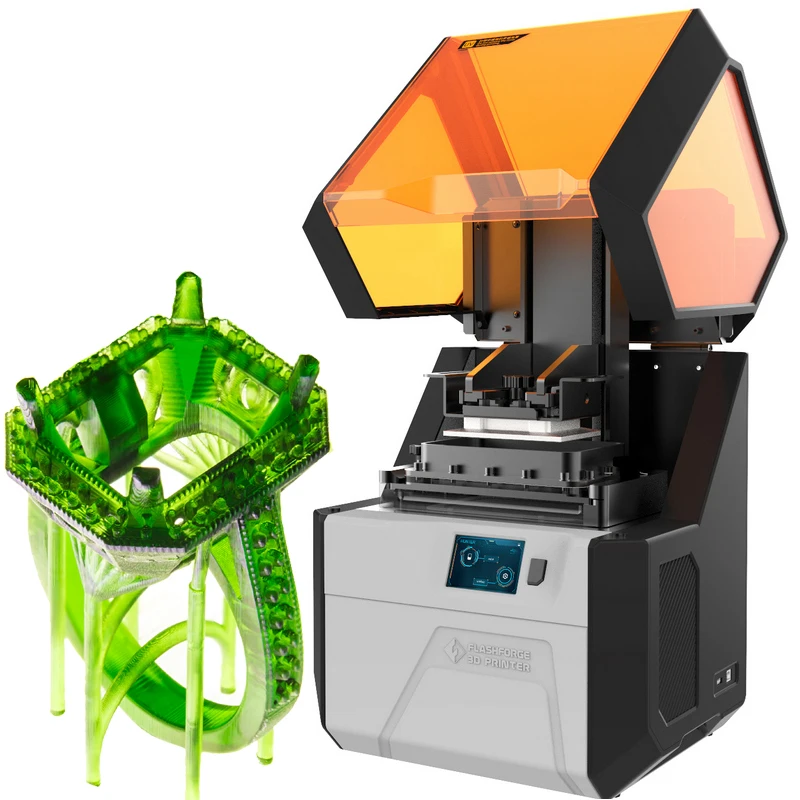 This allows you to quickly produce batches of products with high accuracy.
This allows you to quickly produce batches of products with high accuracy.
Peopoly Phenom XXL
Peopoly Phenom XXL
Specifications:
LCD display resolution: 3840x2160 (23.8", 16:9, UHD 4K)
XY positioning accuracy: 137 µm
UV wavelength: 405 nm
Working area size: 527x296x550 mm
Layer thickness: 0.01-0.3mm
The Peopoly Phenom XXL is a device with a huge build area, which is ideal for serial production of not only jewelry.
Phrozen Sonic MEGA 8K
Phrozen Sonic MEGA 8K
Specifications:
LCD resolution: 15" 8K Mono LCD
XY Positioning Accuracy: 43 µm
UV wavelength: 405 nm
Working area size: 330 x 185 x 400 mm
Layer thickness: 0.01-0.3mm
This is the first LCD printer with 8k monochrome matrix resolution, and a huge working area allows you to produce large batches of products in one print.
MJM/MJP
MJM (or similar PolyJet technology) is a technology for layering photopolymer or wax through many fine nozzles. Typically, the print head is located from 96 to 448, depending on the printer model.
If a photopolymer is used as a material, it is immediately cured by a UV lamp, which is located on the printer's head.
How the MJM printer works
In addition to photopolymer, MJM 3D printers can use wax as a material for printing.
MJM printers can print multiple materials at the same time. This allows you to print complex models with soluble or investment supports. This makes it possible to produce complex models with a smooth surface quickly and easily.
Pros and cons
pros
-
Ability to print multiple materials at the same time. This means that another, soluble material can be used as a support. This allows you to save a lot of time on removing the support from the finished model and cleaning up the places where the supports come into contact with the print.

Minuses
-
To install the printer, most likely, you will need a separate room. 3D printers based on MJM technology are quite bulky in their dimensions, this is not a device that can simply be placed on a desktop or nightstand.
Print examples
Seal of a lot of stencils
Ring printed with wax
Master models made on MJM printer
Lot of jewelry stencils for further casting
Printer rating
FlashForge WaxJet 410
FlashForge WaxJet 410
Specifications:
Materials: Wax, support material.
Resolution: 1200*1200*1600
Building area size: 289*218*150mm
Layer thickness: 16 microns
Accuracy: ±0.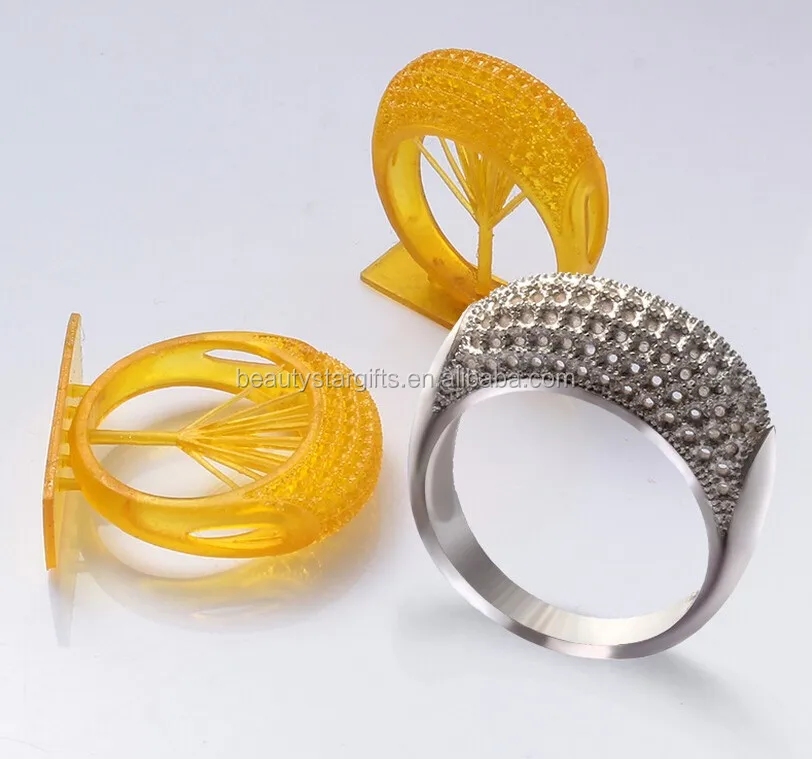 04mm / 20mm
04mm / 20mm
The FlashForge WaxJet 410 is an industrial machine designed for serial printing of wax models, which will then be cast from metal. Machines of this class can be useful not only in jewelry production, but also in the dental industry, aerospace, mechanical engineering, prototyping, etc.
Totals
Photopolymer 3D printers are no longer inferior in detail to professional milling machines. The main advantage of a 3D printer is the ability to produce models of complex geometry with many internal cavities that are physically impossible to produce on a router.
Large firms will appreciate the flexibility that allows them to quickly adapt to customer requirements, as well as quickly produce large and small batches of products due to the shortening of the production chain.
And for a small workshop, a small photopolymer printer with a can of burn-out resin can be a good help, eliminating the need to purchase some expensive machines.
Top 5 Jewelry 3D Printers of 2022 (All Price Ranges!)
Jewelry 3D printing rarely means 3D printing actual wearable items in filament or resin, but instead a jewelry 3D printer is used to create high resolution wax models of the final design in gold or platinum, used to create a mold that is fired and cast by investment casting or lost wax casting.
In fact, many pieces of jewelry are now made in this way. There are entire factories of resin casting 3D printers that create models from wax resin, which are then cast and melted down to create high-end jewelry.
However, having your own jewelry 3D printer gives you more control over your production and saves you money compared to paying someone to print your own molds. Molds for rings and other jewelry can be made for as little as a dollar or two, while you can pay over $25 to have someone print them for you.
Contents
- Jewelry 3D Printing Process
- What are 3D Jewelry Printers?
- Cut and prepare: If it's not already an STL or compatible file, export it.
 Then import it into a 3D slicer and slice it for printing.
Then import it into a 3D slicer and slice it for printing. - Print Model: Use castable wax resin designed for 3D printing jewelry models.
- Molding: Pour the molding material onto the wax model of the jewelry and let it set.
- Melt the wax: Heat the new mold so that the original wax model melts and evaporates, leaving an empty space inside with the exact dimensions of the planned piece of jewelry.
- Casting: Pour molten liquid metal such as gold, silver or platinum into a mold.
- Jewelery 3D Printer Price: $329
- Assembly volume: 129 x 80 x 160 mm
- Jewelry 3D printer price: $1,999
- Assembly volume: 276 x 155 x 400 mm
- 3D Jewelry Price: $3,499
- Assembly volume: 145 x 145 x 185 mm
- Price: Quote required
- Assembly volume: 6″ x 6″ x 4″
- Build Volume: 148 x 83 x 110mm
- Long term money savings: instead of paying a 3d printing service for you, you can 3d print for you $20+ molds print your own wax molds for jewelry for just a dollar each.

Learn more
What are the types of 3D jewelry printers?
Resin 3D printers are considered the best 3D printers for jewelry. They are used with specialized casting wax resins that do not change from a solid to a liquid when heated, but immediately turn into a gas from a solid state.
FDM 3D printers, although common, are very rarely used as jewelry 3D printers. They are not capable of providing the same resolution, sharp surface finish and precision required for complex and delicate jewelry.
3D jewelry prints need to be incredibly detailed and precise - an inaccurate shape will create an inaccurate and featureless piece of jewelry.
In addition, the better the quality of the jewelry 3D printer, the less fine-tuning the jewelry needs to be.
What do jewelry 3D printers produce?
They usually print wax molds for jewelry, such as rings, before stones or individual chain links are set.
However, they can also be used to create similar "fitting pieces" to check that a ring that has not yet been made fits the customer's finger. Although it would be costly and time consuming to make the final ring, an exact copy can be made on a jewelry 3D printer in just a few minutes to check the size.
This eliminates the need to create a piece only to find it doesn't fit. While jewelry molds require special casting resins, standard resins can be used for these parts.
Best Jewelery 3D Printers
1 - Elegoo Mars 2 Pro
Featuring a 6-inch HD 2K monochrome LCD screen, the Elegoo Mars 2 Pro offers accurate jewelery printing for the price.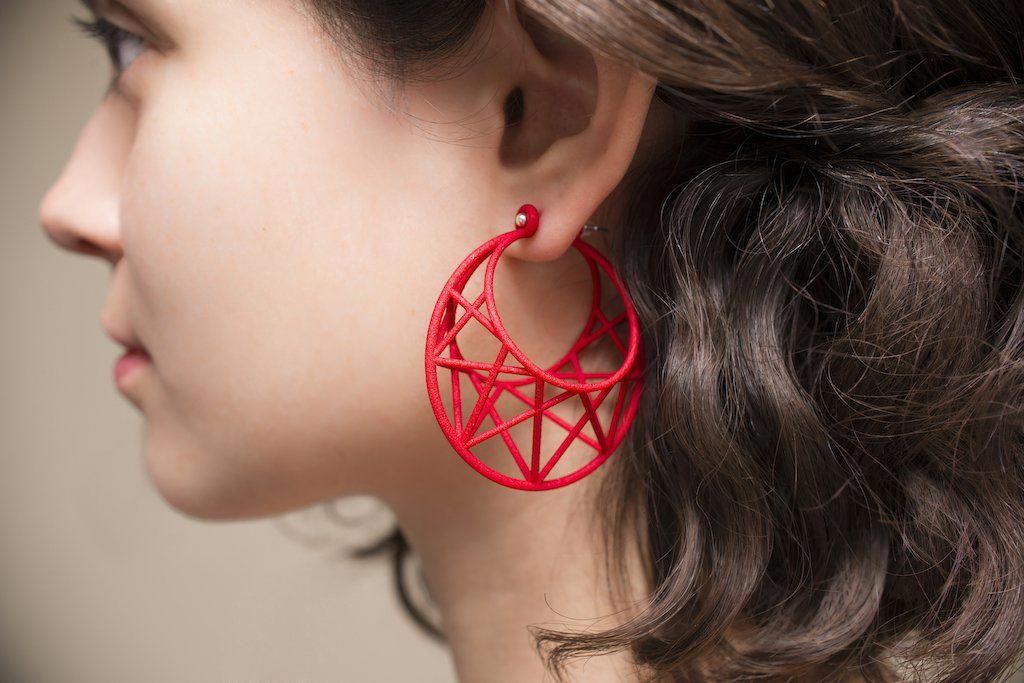 Instead of DLP or SLA, Mars 2 Pro uses LCD printing to cure all layers of resin at once, which speeds up printing speed and allows you to print at speeds of 30-50mm/h.
Instead of DLP or SLA, Mars 2 Pro uses LCD printing to cure all layers of resin at once, which speeds up printing speed and allows you to print at speeds of 30-50mm/h.
The other jewelry 3D printers on this list offer better quality, but for the price, the Mars 2 Pro is a great option. It is durable with CNC-machined aluminum construction for better stability, and the monochrome LCD has been upgraded for longer life to save you money in the long run. This is one of the best 3D printers for jewelry under $500.
The Elegoo Mars has a Z resolution of up to 0.00125 mm, an XY resolution of 0.05 mm and weighs 6.2 kg. It also supports 12 different languages, so if you're not a native English speaker, you can choose your own language.
The video below even shows from start to finish just how accurate wax models for gold jewelry can be made with a standard Elegoo Mars. Even this standard version produces good quality wax models, and the Elegoo Mars 2 Pro has several improvements over the original.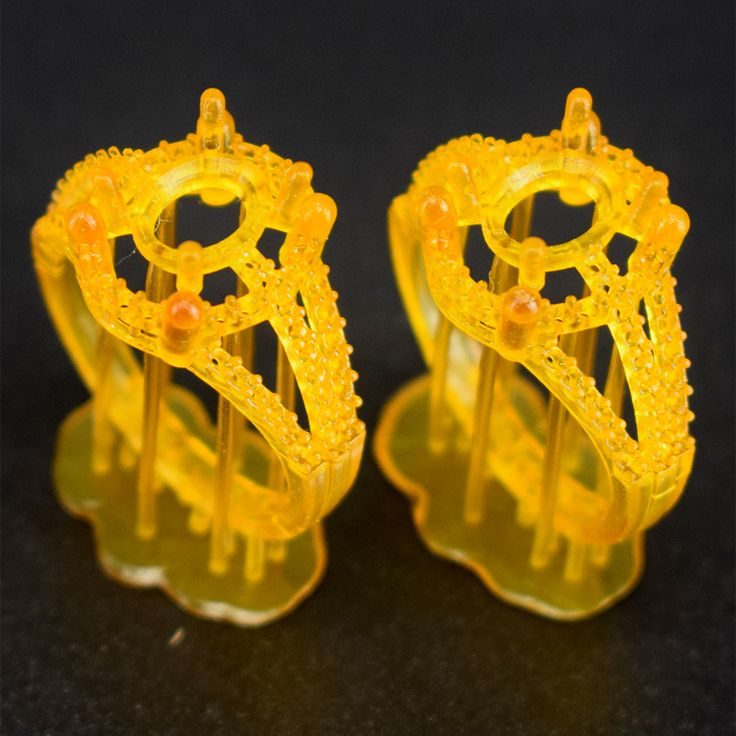
2 - Peopoly Phenom
The Peopoly Phenom offers truly massive print volumes almost unheard of in a jewelry 3D printer. For jewelers who want to produce many rings or other items at the same time, this large volume provides room for dozens of jewelry wax models. If you are in demand for jewelry and want to make as many as possible, then this high build volume is critical.
With high resolution 4K projection quality using MSLA technology, Phenom produces clear, precise and consistent jewelry shapes. MSLA uses elements of LED and LCD technology to produce fast, accurate and reproducible 3D jewelry printing.
For higher print speeds, premium Peopoly Noir is available.
The Phenom uses a Chitubox resin 3D slicer, useful if you've used it before on another printer. Overall, this is one of the best 3D jewelry printers and a great choice for those who want to make a large number of castable wax models of jewelry.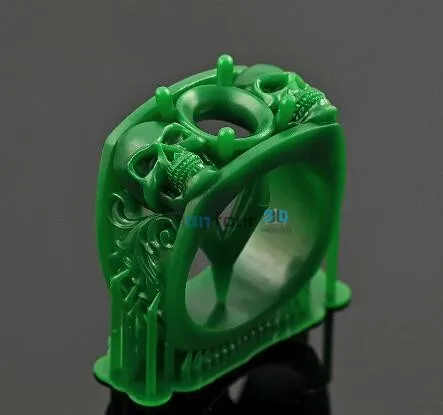
3 - Formlabs Form 3
Regarded as the gold standard for professional resin printing, the Form 3 is capable of fantastic precision, and its new custom light processing unit (LPU) uses lenses and mirrors to accurately print jewelry designs.
For the price, the Form 3 offers 25 micron resolution and very consistent and repeatable printing. Whether you're looking for a jewelry 3D printer capable of flawlessly printing the same design over and over again, or for custom complex designs, the Form 3 can handle both without a hitch.
Formlabs makes their own casting wax resins designed for jewelry with "clear settings, sharp teeth and smooth tangs". Therefore, the Formlabs workflow provides a complete wax-up jewelry manufacturing process, although the Form 3 is also great as a dental 3D printer in other industries.
Form 4 and several jewelery wax patterns printed on it.
4 - Solidscape S325
Soliscape makes custom designed jewelry 3D printers, so any Solidscape printer you buy is optimized for jewelry printing. While other printers such as the Form 3 are designed to work in a variety of industries, the Solidscape S325 is designed exclusively for the jewelry industry. The
S325 is the cheapest of Solidscape's line of jewelry 3D printers. It provides high precision, inkjet wax patterns for accurate and efficient investment casting of precious metals. Solidscape emphasizes that all of their models are suitable for gold and platinum casting and will not expand or contract during the investment casting process.
The S325 is capable of producing 0.001 inch layers with 0.005 inch accuracy. All in all, as a dedicated jewelry 3D printer, Solidscape has a rich history in jewelry 3D printing and can be trusted to deliver high quality and accurate ring wax models time and time again.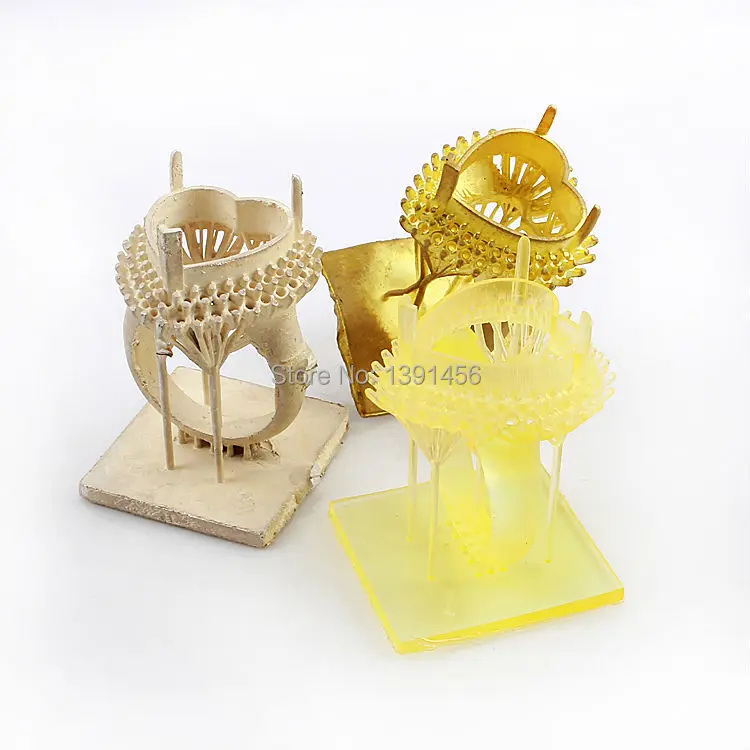
5 - EnvisionTEC D4K Pro Jewelry 3D Printer
Described by EnvisionTEC as the highest resolution, professional-grade desktop 3D printer, as well as claiming the fastest speed, D4K is well suited for jewelry 3D printing. Speed and precision are key in jewelry manufacturing, and the printer's 4K UV DLP projector is capable of quickly creating crisp wax patterns for casting into stunning jewelry.
EnvisionTEC pioneered DLP 3D printing over a decade ago. Now their upgraded D4K Pro can achieve accuracy down to 25 microns in XY and 1 micron in Z.
The 3D Jewelry Printer works well with EnvisionTEC's WIC100 series wax material, which is used for burning and investment casting of precious jewelry. Although it is an industrial 3D printer costing over $10,000, large jewelers will find the D4K one of the best casting jewelry 3D printers.
envisiontec d4k jewelry 3d printer










